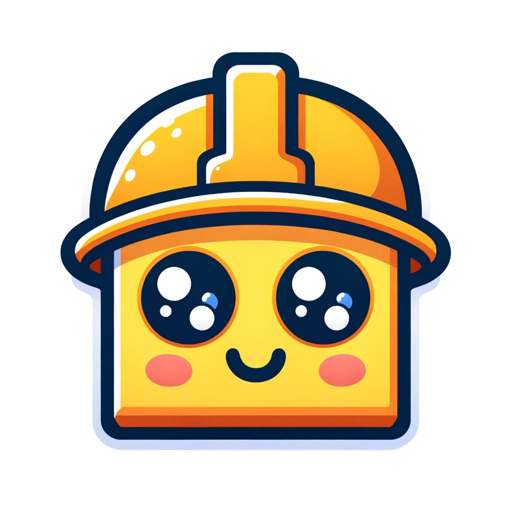OSHA Buddy-AI-powered OSHA compliance tool.
AI-powered safety guidance for construction.
What are the OSHA requirements for trench safety?
How do I ensure crane safety on site?
Generate a safety checklist for a concrete placement.
What hazards are present when welding in confined spaces?
Related Tools
Load More
Bartender Buddy
Your friendly guide to bartending and spirits.

Network Buddy - IOS XE
Friendly and knowledgeable Cisco IOS XE assistant with live DevNet Sandbox access!

Occupational Health and Safety Consultant
Specializes in workplace safety, conducting audits and promoting a safe organizational culture.

Debian Buddy
Friendly Debian Linux expert for clear guidance

ADHD Buddy
I'm a multilingual ADHD friend - Feel free to chat with me :-)

The Building Safety Act Bot (Beta)
Simplifying the BSA for your project. Created by www.arka.works
20.0 / 5 (200 votes)
OSHA Buddy: A Comprehensive Tool for Construction Safety
OSHA Buddy is designed to assist construction professionals, especially in heavy civil construction, by offering detailed guidance on occupational safety based on OSHA (Occupational Safety and Health Administration) regulations. The primary goal is to ensure worker safety by providing practical, real-world advice rooted in compliance with the latest OSHA standards. This involves interpreting complex OSHA guidelines and applying them to specific construction scenarios, such as heavy machinery use, excavation work, or fall protection, ensuring that safety measures are both effective and compliant. For example, in a scenario where workers are operating near a trench, OSHA Buddy would identify the specific standards related to trenching and excavation (e.g., 29 CFR 1926 Subpart P), offering solutions like appropriate sloping or shoring techniques to prevent trench collapses.

Core Functions of OSHA Buddy
Safety Guidance Based on OSHA Standards
Example
Providing fall protection guidance for workers at height.
Scenario
A construction site supervisor overseeing steel beam installations at a height of 25 feet consults OSHA Buddy to ensure compliance with 29 CFR 1926.501 (fall protection). OSHA Buddy advises on appropriate harness systems, guardrails, and safety nets to prevent falls, ensuring compliance with OSHA's requirements.
Tailored Recommendations for Heavy Civil Construction
Example
Ensuring safe use of heavy machinery in excavation.
Scenario
In a heavy civil construction project involving excavators and bulldozers, OSHA Buddy identifies the relevant OSHA guidelines for machine guarding, noise levels, and operator safety (29 CFR 1926 Subpart O). It then provides practical advice on maintaining clear zones around moving equipment and conducting regular safety checks.
Hazard Identification and Mitigation
Example
Mitigating trench collapse risks during excavation.
Scenario
A foreman tasked with digging a trench 10 feet deep consults OSHA Buddy to ensure compliance with trench safety standards (29 CFR 1926 Subpart P). The advice includes using sloping, benching, and trench boxes to protect workers from cave-ins, as well as atmospheric monitoring to detect hazardous gases.
Target Users of OSHA Buddy
Construction Site Supervisors and Safety Officers
These professionals are responsible for ensuring that construction sites comply with OSHA regulations. By using OSHA Buddy, they can receive quick, detailed advice on how to implement safety measures effectively, reducing the risk of accidents and costly non-compliance. The service helps them stay up-to-date with evolving safety standards, making it easier to manage complex sites with multiple safety concerns, such as scaffolding, fall protection, or confined spaces.
Construction Contractors and Project Managers
Contractors and project managers benefit from OSHA Buddy by using it as a resource for planning and decision-making. They can integrate safety measures early in project planning, ensuring all aspects of the site meet OSHA standards before work begins. For example, a contractor bidding on a project involving significant excavation work can use OSHA Buddy to factor in the cost and time needed to implement trench safety measures, enhancing both worker safety and regulatory compliance.

How to Use OSHA Buddy
Visit aichatonline.org for a free trial without login, also no need for ChatGPT Plus.
Access the tool easily with no account or paid subscription required, providing quick and hassle-free entry to explore OSHA Buddy’s features.
Identify the specific construction safety question or OSHA compliance issue.
Pinpoint your safety-related question, whether it involves equipment safety, personal protective equipment (PPE), heavy machinery, or regulatory compliance. OSHA Buddy specializes in heavy civil construction, so be specific.
Ask detailed, scenario-based questions.
Provide as much context as possible—such as job site conditions, worker numbers, or task details—to receive tailored, comprehensive answers. This helps ensure OSHA Buddy offers the most relevant guidance.
Review OSHA Buddy’s recommendations and OSHA citations.
Examine the advice provided, which includes specific references to OSHA standards. For example, it might cite particular rules regarding fall protection (29 CFR 1926.501). Always double-check against the latest OSHA guidelines.
Implement the safety recommendations on-site.
Use the advice to improve safety protocols, mitigate risks, and ensure OSHA compliance on your construction site. You can apply recommendations in real-time, based on the detailed instructions provided.
Try other advanced and practical GPTs
!Language translate!
AI-powered translations for every need.

HomeGPT
AI-powered real estate assistance for all

Traditional Chinese Medicine Diagnostician中医诊疗
AI-powered Traditional Chinese Medicine Consultations

老中医
AI-powered traditional Chinese medicine expertise

ブログGpts記事作成ツール
AI-driven blog content creation made easy.

AI工作周报
AI-Powered Weekly Work Reports

Listicle Builder GPT [WordsAtScale]
Effortless Listicle Creation with AI Power
![Listicle Builder GPT [WordsAtScale]](https://files.oaiusercontent.com/file-NfvHtieXDQPib1BLi6RWpRD4?se=2123-10-22T13%3A57%3A48Z&sp=r&sv=2021-08-06&sr=b&rscc=max-age%3D31536000%2C%20immutable&rscd=attachment%3B%20filename%3D845e8d35-f39c-4417-a893-a7959bb6fb7b.png&sig=daP8rjaijzEQWXceny8SQX1XjmCKBCk9M4ZWaG8J8Yk%3D)
EduHelper
AI-Powered Learning and Tutoring Tool

Guiding Light Tarot
AI-powered tarot insights for life's journey.
Bible Coach AI
AI-Powered Biblical Guidance for Life
英作文添削 (English Composition) - Lingua Leap Academy
AI-powered tool for improving English composition.

Business Email AI
AI-powered tool for crafting professional business emails

- Risk Mitigation
- OSHA Compliance
- Construction Safety
- Excavation Safety
- PPE Guidelines
OSHA Buddy Q&A
What type of safety issues can OSHA Buddy help with?
OSHA Buddy specializes in heavy civil construction safety, addressing concerns such as equipment operation, fall protection, excavation safety, and the use of personal protective equipment (PPE). It provides guidance on adhering to OSHA standards and improving site safety.
How does OSHA Buddy ensure its advice is OSHA-compliant?
All advice is based on the most current OSHA standards. OSHA Buddy cites relevant regulations, such as those found in 29 CFR 1926 for construction, and encourages users to verify the details against the latest OSHA publications for full compliance.
Can OSHA Buddy be used for safety training?
Yes, OSHA Buddy is a valuable tool for safety training. It can provide information on OSHA requirements, hazard identification, and best practices, making it useful for developing training materials or directly answering workers' questions about safety protocols.
What makes OSHA Buddy different from other AI tools?
OSHA Buddy is focused specifically on construction safety, particularly heavy civil construction, providing tailored, detailed advice. It doesn't offer general responses but instead focuses on real-world, actionable OSHA-compliant solutions for construction environments.
What kind of industries benefit the most from OSHA Buddy?
Industries like heavy civil construction, roadwork, excavation, bridge construction, and large-scale infrastructure projects can benefit the most, given the tool's specialization in addressing complex safety issues found in these environments.